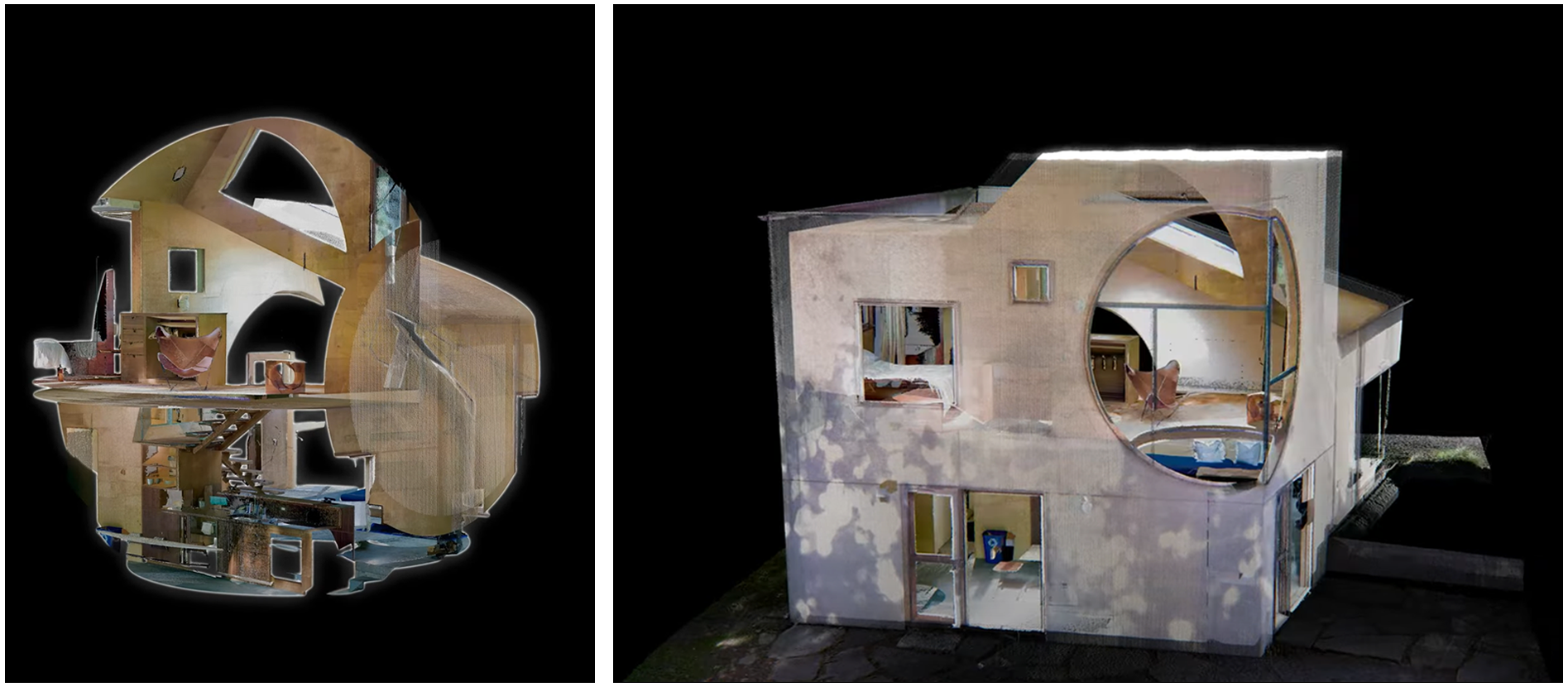When a new product comes out, we all know that it’s time for in-field tests. The all-new BLK360 breaks the barriers of speed when it comes to reality capture, and its ease of use makes it even more powerful on job sites, ranging from construction to architecture and even to heritage and media and entertainment.
Disclaimer: The Leica BLK360 G1 is no longer for sale. Use this article to explore the differences and improvements between the original model and the latest Leica BLK360.
So for our first field trip, we went to the Ex of In House in Rhinebeck, NY, to see how well the new BLK360 and the BLK360 G1 compared, especially when scanning such a unique space.
The Ex of In house is a study in how to make the most of interior space in a modern home. It began as a research project by architects Steven Holl and Dimitra Tsachrelia. The home itself is a trapezoid that is intersected by spheres, and the spheres—the rooms and passageways of the home—are the main event, not the exterior. The true nature of the project is the exploration of the interior, where we live. Ex of In. And that’s what we scanned.
But with the BLK360 scanners—both old and new—a complicated structure became a digital twin with a simple and fast workflow.
Get ready, set, and go!
We began our scanning project with the natural starting point: the entry to the house. A quick note: the unique geometry of the location makes it a unique challenge to scan. Curving and non-parallel lines make accurate capture of the space a time-consuming process for traditional capture techniques. Luckily for our BLK scanners, we can overcome these hurdles by simply taking more scans, which is where the improvements in the new BLK360 began to show themselves. At under twenty seconds per scan, including images, the new BLK360 had a huge head start.
While the accuracy of the BLK360 G1 is comparable to the new BLK360 (6mm accuracy at 10m for the BLK360 G1 vs the new BLK360's 4mm accuracy at the same distance), the new BLK360 is simply much faster. It is made for rapid reality capture where speed is critical, yet accuracy is not sacrificed. The BLK360 G1 remains a powerful tool for reality capture but it takes longer to complete each scan. Either scanner can be a great option depending on your need for speed.
How about that VIS?
In addition to faster reality capture speed, the new BLK360 also distinguishes itself from the BLK360 G1 by the inclusion of Leica Geosystems’ Visual Inertial System technology, or VIS.
VIS tracks the scanner’s movement between scans and combines scans automatically in the field—thus speeding up the process of gathering all captured data into one dataset of the entire home. VIS was previously only available on scanners like the Leica RTC360, but we’ve taken the technology and built it right into the new BLK360.
What does VIS really do? It uses the scanner’s cameras to track its position in between scans. This means that the new BLK360 knows where it is in relation to its previous scan. What you get with VIS is a complete dataset instead of a series of individual scans that you need to register later.
The benefit is twofold: ease of scanning (you can monitor VIS on the BLK Live app) and scans that are combined in-field rather than in the office. This gives you even more speed and saves time. While the BLK360 G1 does not have VIS, it’s still a great option if you’re not concerned with aligning your scans on site. It also has a thermal camera, which the new BLK360 does not have, so if you need thermal imagery, the BLK360 G1 is a good fit.

Two devices, almost the same workflow
Because both the BLK360 G1 and the new BLK360 are terrestrial laser scanners—or, scanners that scan from a static position, like a tripod—the workflow is very much the same. You set it up, push the button, wait for the scan to complete (being mindful of staying out of the scan!), and then pick up the scanner to move to your next setup.
That’s what we call push-button scanning—not even using an app to track your progress (the BLK360 G1 can be monitored using Cyclone FIELD 360 instead of the BLK Live app). It’s a very simple and fast way to scan, and you can do it with both devices—but it doesn’t give you the benefit of using an app.
With the BLK360 G1, you have Cyclone FIELD 360, and with the new BLK360, you have the BLK Live app and Cyclone FIELD 360. Either app will give you a sense of what you’re scanning, where you’re scanning, and offer options for scanner settings. But the BLK Live app is more streamlined, is purpose-made for the BLK360, and offers live scan rendering feedback to see what you’ve captured and what you might have missed.
Whichever device you choose, you have the option of simple push-button scanning (no app) or reality capture with further functionality, control, and possibilities with app-based control and feedback. The workflows are essentially the same. One downstream benefit you gain from the new BLK360 is the complete dataset, aligned by VIS, and you’d need to make up for that by doing manual registration with BLK360 G1 data.
Summing it up
For the Ex of In House, we captured complete datasets of the interior of the house using both devices without any issues. The biggest difference was speed, with the new BLK360 being up to five times faster than its predecessor.
Either scanner you choose, you’ll be able to capture an accurate digital twin of whatever spaces or objects you decide to scan. And if you want to learn more to see which scanner is right for you, click here to see the in-depth comparison.



